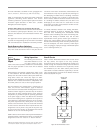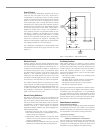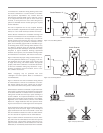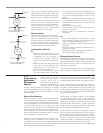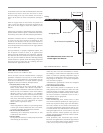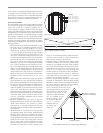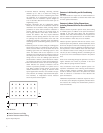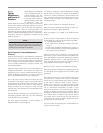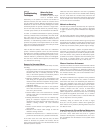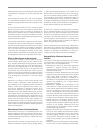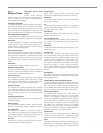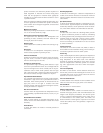
SYSTEM SENSOR
15
NFPA standards require and smoke detector manufacturers
recommend that all detectors be visually inspected twice
a year.
Clean the detectors at least once a year, or more frequent-
ly if environmental conditions warrant it. See the section
on Detector Testing and Maintenance in this guide for more
details.
In cases where the probable cause of a number of alarms
appears to be dust or dirt on the detectors, detector main-
tenance schedules should be reviewed to determine the
dates when the detectors were last cleaned and tested. If
the detectors are due or overdue for maintenance, schedul-
ing and performing the recommended cleaning and testing
should eliminate the problem.
If the problem resulted from a temporary overall increase
in airborne dust due to nearby construction, scheduling a
one-time special cleaning for all the detectors in the system
should alleviate the problem. If the problem is confined to
one or two zones and is the result of higher dust levels in
a particular area, scheduling the detectors in those areas
for more frequent maintenance and cleaning may prevent
the development of similar alarm problems in the future.
Effects of Other Systems on Alarm System
In checking for the effects of other systems on the alarm
system wiring the Alarm Log may be very valuable in help-
ing to pinpoint relationships among apparently causeless
alarms. One important fact that can be obtained from an
Alarm Log is the beginning date for a rash of apparently
causeless alarms that may or may not be grouped around
one particular zone. The sudden onset of such a group of
alarms may result when an addition or change in the alarm
system or in another electrical or electromechanical system
in the building affects the detectors or the alarm system
circuitry.
Systems that can affect the alarm system include: other
security systems; walkie-talkie; mobile telephones; heat-
ing, ventilating, and air conditioning controls; elevator call
systems; remote control equipment (door closers, etc.);
and even the installation of microwave antenna. If the
alarm pattern supports the possibility of some kind of
interference with a fairly definite initiation date, all equip-
ment changes made in the building immediately prior to or
concurrent with the beginning of the development of the
alarm pattern should be reviewed. In addition, the wiring
layouts of the alarm system and any recent building or sys-
tem modifications should be compared to make sure that
the spacing and/or shielding required to protect the alarm
system wiring from other potentially interfering electrical
systems was maintained.
Miscellaneous Causes of Unwanted Alarms
Isolated alarm causes such as a maintenance person acci-
dentally triggering an alarm by touching a detector with a
magnetic screwdriver can be ignored, except to periodical-
ly remind maintenance personnel to be careful when work-
ing around detectors.
Steps should also be taken to protect detectors from dust
whenever maintenance requires sawing, sanding, drilling,
or other dust-producing operations in the vicinity of the
detector heads to prevent false alarms due to the dust get-
ting into the detector sensing chambers. In new construc-
tion applications drywall dust contamination affects all
types of smoke detectors. To help overcome this problem, it
is strongly recommended that installation of detector heads
be delayed until after drywall installation is completed or to
protect detector heads from dust contamination.
If alarms occur whenever the heating system is turned on
after an extended shutdown, due to the accumulated dust
burning off as the system components heat, the detector
system can be turned off for a short period while the heat-
ing system is activated and checked out, or the start-up of
the heating system can be scheduled for an evening, week-
end or other off-hours period to minimize the effects of
alarms on regular daytime activities.
Not all unwanted alarms are caused by dirt, interference or
other effects on the detectors. If the control panel shows an
alarm but no detectors in the zone are indicating an alarm
condition, the possibility of interference or a failure of a
control panel component should also be investigated.
Responsibilities of Detector Owners and
Installers
The owners of smoke detector-equipped fire alarm systems
are responsible for maintaining the integrity of the detec-
tion system. This can be accomplished by:
• Maintaining an Alarm Log and training appropriate
personnel to properly maintain the system as
described above in the section titled What To Do When
Unwanted Alarms Occur.
• Maintaining a Detector Maintenance Log that records
inspection, testing and cleaning data for each detector
in the system. (Refer to Section 6 of this manual –
Testing, Maintenance and Service of Detectors for
information on recommended testing and maintenance
intervals and procedures, and a sample Detector
Maintenance Log page.)
• Maintaining a complete file of information on the
alarm system in a readily accessible location. This file
should include specifications and installation instruc-
tions for the detectors, control panel, and auxiliary
devices, wiring diagrams and wire location informa-
tion, and the manufacturer’s recommendations for iso-
lating the detection system wiring from other electrical
wiring to prevent interference and unwanted alarms.
• Making certain that maintenance personnel or con-
tractors working on the building’s electrical systems
are given copies of the alarm system wiring layout and
locations so that potential interference from other
wiring systems can be prevented by proper insulation
and spacing during installation.
•Keeping accurate records of installation and modifica-
tions to all other building electromechanical systems
that could cause interference with the alarm system,
including updating schematics, wiring layouts, and
wiring location information whenever changes are
made, so that problems can be promptly found and
eliminated.
• Making a record of everything done during investiga-
tion of a series of alarms, indicating a problem exists.



